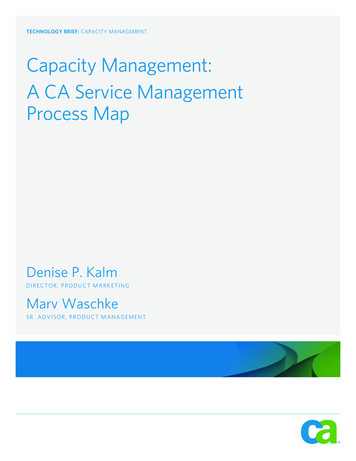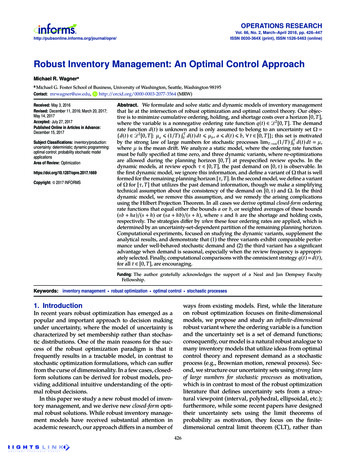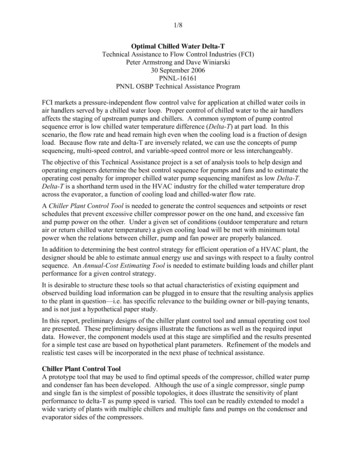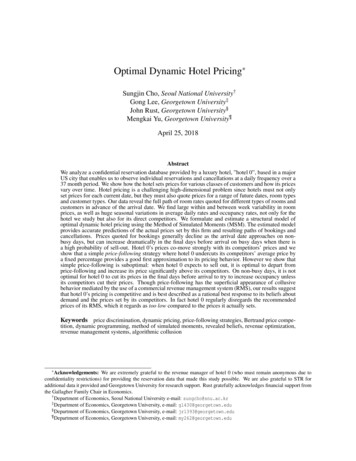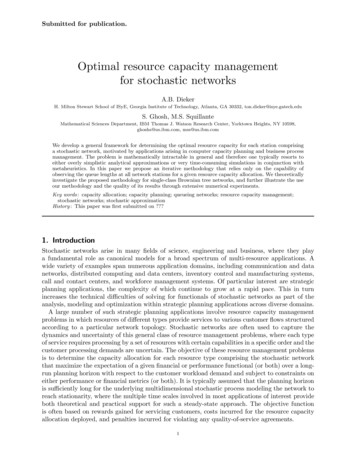
Transcription
Submitted for publication.Optimal resource capacity managementfor stochastic networksA.B. DiekerH. Milton Stewart School of ISyE, Georgia Institute of Technology, Atlanta, GA 30332, ton.dieker@isye.gatech.eduS. Ghosh, M.S. SquillanteMathematical Sciences Department, IBM Thomas J. Watson Research Center, Yorktown Heights, NY 10598,ghoshs@us.ibm.com, mss@us.ibm.comWe develop a general framework for determining the optimal resource capacity for each station comprisinga stochastic network, motivated by applications arising in computer capacity planning and business processmanagement. The problem is mathematically intractable in general and therefore one typically resorts toeither overly simplistic analytical approximations or very time-consuming simulations in conjunction withmetaheuristics. In this paper we propose an iterative methodology that relies only on the capability ofobserving the queue lengths at all network stations for a given resource capacity allocation. We theoreticallyinvestigate the proposed methodology for single-class Brownian tree networks, and further illustrate the useour methodology and the quality of its results through extensive numerical experiments.Key words : capacity allocation; capacity planning; queueing networks; resource capacity management;stochastic networks; stochastic approximationHistory : This paper was first submitted on ?1. IntroductionStochastic networks arise in many fields of science, engineering and business, where they playa fundamental role as canonical models for a broad spectrum of multi-resource applications. Awide variety of examples span numerous application domains, including communication and datanetworks, distributed computing and data centers, inventory control and manufacturing systems,call and contact centers, and workforce management systems. Of particular interest are strategicplanning applications, the complexity of which continue to grow at a rapid pace. This in turnincreases the technical difficulties of solving for functionals of stochastic networks as part of theanalysis, modeling and optimization within strategic planning applications across diverse domains.A large number of such strategic planning applications involve resource capacity managementproblems in which resources of different types provide services to various customer flows structuredaccording to a particular network topology. Stochastic networks are often used to capture thedynamics and uncertainty of this general class of resource management problems, where each typeof service requires processing by a set of resources with certain capabilities in a specific order and thecustomer processing demands are uncertain. The objective of these resource management problemsis to determine the capacity allocation for each resource type comprising the stochastic networkthat maximize the expectation of a given financial or performance functional (or both) over a longrun planning horizon with respect to the customer workload demand and subject to constraints oneither performance or financial metrics (or both). It is typically assumed that the planning horizonis sufficiently long for the underlying multidimensional stochastic process modeling the network toreach stationarity, where the multiple time scales involved in most applications of interest provideboth theoretical and practical support for such a steady-state approach. The objective functionis often based on rewards gained for servicing customers, costs incurred for the resource capacityallocation deployed, and penalties incurred for violating any quality-of-service agreements.1
2Dieker, Ghosh, and Squillante: Optimal resource capacity management for stochastic networksOur present study of resource capacity management problems in stochastic networks is primarilymotivated by two particular application domains, although the same class of problems arise naturally in many other domains. The first application domain concerns capacity planning across awide range of computer environments. This area has traditionally received a great deal of attentionwithin the context of high-performance computing and Internet-based computing environments.However, with the recent proliferation of large-scale data centers and cloud computing platforms(see, e.g., Dikaiakos et al. (2009), Armbrust et al. (2009), Gartner (2012), Iyoob et al. (2012)),this application domain has become an even more important source of resource capacity management problems in practice. For these problem instances, the computer infrastructure is modeledas a stochastic network reflecting the topology of the infrastructure and the uncertainty of boththe customer processing requirements and the overall demand. Various companies, such as BMCSoftware and IBM, provide products that address these resource capacity management problemswithin the context of information technology service management, data center automation, andcomputer performance management. The objectives of such solutions include minimizing the costsof a computing infrastructure while satisfying certain performance targets, as well as maximizingperformance metrics within a given computing infrastructure budget.The second application domain motivating our present study is business process management,which is a key emerging technology that seeks to enable the optimization of business processoperations within an organization. Here, a business process generally consists of any series ofactivities performed within an organization to achieve a common business goal, such that revenuescan be generated and costs are incurred at any step or along any flow comprising the process. Asimple business process example is the processing of various types of medical claims by an insurancecompany. Another recent representative example is the flow of patients through the emergencydepartment of a hospital, where the goal is to address a chronic inability of hospitals to deliveremergency services on demand in a highly dynamic and highly volatile environment in which thefailure to match demand carries significant clinical risks to patients and financial risks to thehospital; see Guarisco and Samuelson (2011). For these problem instances, the business process ismodeled as a stochastic network reflecting the topology of the series of activities to be performedand the uncertainty of both the processing requirements for each activity and the overall demand.Various companies, such as IBM and Oracle, provide products that address these resource capacitymanagement problems within the context of business process modeling and optimization.The primary state-of-the-art approaches for solving resource capacity management problems instochastic networks from the two foregoing application domains fall into two main categories. Thesetwo sets of solution approaches also represent the state-of-the-art for a wide variety of applicationdomains beyond our motivating applications. The first category of solution approaches is basedon fairly direct applications of product-form network results, despite the fact that the underlyingstochastic network does not have a product-form solution. Indeed, it is only under strong restrictionsthat the stationary joint distribution for the stochastic network is a product of the stationarydistribution for each queue in isolation (see, e.g., Baskett et al. (1975), Harrison and Williams(1992)). This approach is often employed in computer capacity planning applications, even thoughthe requirements for product-form solutions almost always never hold in practical capacity planninginstances across a broad spectrum of computer environments. Instead, the approach is used asa simple approximation typically together with a wide range of ad hoc heuristics, which includeapplying product-form results for performance metrics of interest in a modified version of theoriginal stochastic network in an attempt to address characteristics that yield a network with a nonproduct-form solution; e.g., refer to Menasce and Almeida (1998, 2000), Menasce et al. (2004) andthe references therein. One example of this approach consists of increasing the service requirementsof customers at a bottleneck resource in an attempt to have the results reflect the types of burstyarrival processes often found in computer environments. Another example consists of (artificially)
Dieker, Ghosh, and Squillante: Optimal resource capacity management for stochastic networks3splitting the customer service requirements at a network station into multiple classes in an attemptto capture heavy tails in the service time distributions (ignoring correlation effects). Althoughthe closed-form expressions render a direct solution for the corresponding optimization problemin a very efficient manner, the serious accuracy problems inherent in this simple approximationapproach have been well established and thus are a great concern from both a theoretical andpractical perspective.The second category of state-of-the-art solution approaches is based on simulation-based optimization. Here, the literature can be broadly divided into those that use a broad spectrum ofmetaheuristics (e.g., tabu search, scatter search, neural networks) to control a sequence of simulation runs in order to find an optimal solution (see, e.g., Glover et al. (1999) and Chapter 20in Nelson and Henderson (2007)), and those that apply several direct methods (e.g., stochasticapproximation) which have been widely studied to address simulation-based optimization problemswith a more rigorous theoretical foundation (refer to, e.g., Chapter 8 in Asmussen and Glynn (2007)and Chapter 19 in Nelson and Henderson (2007)). A great disadvantage of all these simulationbased optimization methods, however, is the often prohibitive costs in both time and resourcesrequired to obtain optimal solutions in practice for problems involving multidimensional stochasticnetworks. This is in large part due to the numerous parameters involved in each method that mustbe set via experimental tweaking for every problem instance. In fact, a recent study illustrates howsimulation-based optimization can require on the order of a few days to determine optimal resourcecapacity levels in a much simpler class of stochastic processes than those considered in the presentpaper; see Heching and Squillante (2013).The metaheuristic approach is often employed in business process management applications,where there is essentially exclusive use of simulation for the analysis and optimization of stochasticnetwork representations of business processes; refer to, e.g., Laguna and Marklund (2004). Moregenerally, the metaheuristic approach is employed in nearly all major simulation software products that support optimization, such as those offered by Arena and AnyLogic through partnershipwith companies like OptTek that provide a software control procedure which integrates variousmetaheuristic methods. At each step of the control procedure, there is a comparison between thesimulation results for the current set of decision variables (server capacity in our application) andthose for all previous settings, and then the procedure suggests another set of decision variable values for the next simulation run. Once no further improvement to the results is observed, the controlprocedure terminates and the best set of decision variable values found through this sequence ofsimulation runs are selected to be an (local) optimum. The metaheuristic approach ignores anystructure of the underlying stochastic network, and therefore can be prone to accuracy concernswith respect to the true optimal solution from both a theoretical and practical perspective.The stochastic approximation algorithm for simulation-based optimization has been extensivelystudied in great generality with rigorous results available on the rates of convergence under reasonable conditions for the objective function. These methods are regrettably not as common inpractice as the metaheuristic approach. One stumbling block has been that the method requiresthe setting of certain critical parameters to “good” values in order to realize an efficient implementation, where practitioner experience demonstrates that “good” values typically depend on eachinstance of the problem being solved. As our results further demonstrate and quantify, this important requirement of stochastic approximation to find “good” values for certain critical parametersremains a key problem in practice for the general stochastic networks of interest in this study.In this paper, our goal is to develop a general solution framework that provides the benefits ofeach of the above solution approaches while also addressing their serious limitations. Namely, weseek to realize the efficiency of analytical methods together with the accuracy of simulation-basedmethods within a unified framework for solving resource capacity management problems. We devisea two-phase solution framework in which a new and general form of stochastic decomposition is
4Dieker, Ghosh, and Squillante: Optimal resource capacity management for stochastic networksderived and leveraged as part of a fixed-point iteration in the first phase to obtain a nearly optimalsolution in a very efficient manner. The second phase, taking the first-phase solution as a startingpoint, then exploits advanced methods that deal directly with the original network to obtain anoptimal solution. A good candidate for our second-phase solution is the stochastic approximationalgorithm, given that it represents the only simulation-based optimization approach with a rigoroustheoretical foundation. It is important to note, however, that any direct method can be used asthe basis of the second phase of our framework. This second phase is much more accurate thanthe first phase, at the expense of much higher computational and temporal costs, but the nearlyoptimal starting point from the first phase allows us to leverage these detailed methods in amore surgical manner. By establishing and exploiting fundamental properties of the underlyingmultidimensional process of the stochastic network throughout this framework, we believe thatsignificant improvements in computational costs and solution accuracy are possible over variousstate-of-the-art approaches for solving resource capacity management problems in general.Our study includes a wide variety of numerical experiments to investigate the performance ofa particular realization of our general solution framework over a broad range of problem settings.The results of these experiments clearly and convincingly demonstrate the significant benefits ofour general solution framework over existing state-of-the-art approaches, namely product-form andstochastic approximation solutions. In particular, we show that the two-phase framework providesvastly superior results than product-form solutions and converges much faster than stochasticapproximation approaches with respect to finding (locally) optimal solutions. Moreover, the principle new stochastic decomposition algorithm introduced as an accelerant in the first phase performsvery well in producing good approximate solutions that are typically within a tiny percentage ofoptimality for well-behaved problem settings and within 5% of optimality in more diverse settings.This is of great advantage to the general user in practice because the algorithm has no parametersthat must be tweaked to obtain such fast convergence to good approximate solutions. These highquality approximations support efficient exploration of the entire resource capacity managementspace across various assumptions, conditions, scenarios and workloads. Furthermore, these highquality approximations as starting points obviously benefit the method used in the second phase. Incontrast, our numerical experiments clearly illustrate the difficulty encountered by users in tuningparameters to realize the best results from the sole use of the stochastic approximation algorithm.The remainder of this paper is organized as follows. Section 2 presents our general solution framework. We then consider in Section 3 a specific instance of our general problem, namely a single-classBrownian tree network, for which we derive structural properties that play a fundamental role in ananalysis of our algorithm presented in Section 4, including results on uniqueness, convergence andbounded optimality gap in the tree-network setting. A representative set of numerical experimentsare provided in Section 5, which includes a brief introduction to the stochastic approximation algorithm. Concluding remarks then follow, with the appendices presenting additional technical detailsand some of our proofs.Notation. All vectors in this paper are L-dimensional, where L represents the number ofstations in the network. Throughout, we use boldface for vectors and identify their elements throughsubscripts: the i-th element of the vector v is given by vi . We similarly use boldface for vectorvalued functions regardless their domain, and write for instance fi (x) for the i-th element of f (x).We also write hu, v i for the inner product of vectors u and v.2. A General ApproachThe complexity of solving resource capacity management problems is due in great part to thetechnical difficulties of solving for functionals of stationary stochastic networks. A major source of
Dieker, Ghosh, and Squillante: Optimal resource capacity management for stochastic networks5difficulty in such analysis, modeling and optimization of stochastic networks concerns the multidimensional aspects of the underlying stochastic processes, which involve various dependencies anddynamic interactions among the different dimensions of the multidimensional process.In this section, we present our general approach to address these complexities and difficulties indeveloping a novel resource capacity management solution framework. We first discuss the basicidea to provide a proper context for our approach, and then we formally present our generalsolution framework. Due to the highly nonlinear and possibly nonconvex nature of resource capacitymanagement problems in general, our focus lies on finding “good” local optima.2.1. Basic ideaGiven our goal of developing a solution approach that provides the efficiencies of analytical methodstogether with the accuracies of simulation-based methods, we devise a general two-phase solutionframework for optimal resource capacity management problems in stochastic networks.The first phase is based on a fixed-point iteration approach where observed queue lengths at thecurrent iterate determine the resource capacity allocation for the next iterate. If one of the queuelengths is disproportionally high in the current iterate, the next iterate will allocate more resourcecapacity at the corresponding station. This process repeats, forming the basis of an efficient fixedpoint iteration that renders a nearly (locally) optimal solution to the resource capacity managementproblem. Depending on the stochastic network setting in which our general solution framework isapplied, the required queue length information can be obtained from (a combination of) advancedanalytical (e.g., Baskett et al. (1975), Dieker and Gao (2011), Harrison and Williams (1992),Pollett (2009)), numerical (e.g., Dai and Harrison (1992), Saure et al. (2009)) or simulation-based(e.g., Asmussen and Glynn (2007), Nelson and Henderson (2007)) methods. As a result, our firstphase approach can be applied to stochastic networks that are analytically intractable as long asthey can be simulated.Our iterative algorithm updates resource allocations based on the square root of the observedqueue lengths, as motivated and formalized mathematically in the next subsection. Roughly speaking, our updating rule is derived from an appropriate separable functional form for performancemetrics of each station in the network, such as expected steady-state queue length or expectedsteady-state
Dieker, Ghosh, and Squillante: Optimal resource capacity management for stochastic networks 2 Our present study of resource capacity management problems in stochastic networks is primarily motivated by two particular application domains, although the same

